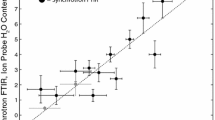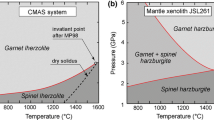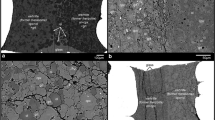Abstract
We performed a series of piston-cylinder experiments on a synthetic pelite starting material over a pressure and temperature range of 3.0–5.0 GPa and 1,100–1,600°C, respectively, to examine the melting behaviour and phase relations of sedimentary rocks at upper mantle conditions. The anhydrous pelite solidus is between 1,150 and 1,200°C at 3.0 GPa and close to 1,250°C at 5.0 GPa, whereas the liquidus is likely to be at 1,600°C or higher at all investigated pressures, giving a large melting interval of over 400°C. The subsolidus paragenesis consists of quartz/coesite, feldspar, garnet, kyanite, rutile, ±clinopyroxene ±apatite. Feldspar, rutile and apatite are rapidly melted out above the solidus, whereas garnet and kyanite are stable to high melt fractions (>70%). Clinopyroxene stability increases with increasing pressure, and quartz/coesite is the sole liquidus phase at all pressures. Feldspars are relatively Na-rich [K/(K + Na) = 0.4–0.5] at 3.0 GPa, but are nearly pure K-feldspar at 5.0 GPa. Clinopyroxenes are jadeite and Ca-eskolaite rich, with jadeite contents increasing with pressure. All supersolidus experiments produced alkaline dacitic melts with relatively constant SiO2 and Al2O3 contents. At 3.0 GPa, initial melting is controlled almost exclusively by feldspar and quartz, giving melts with K2O/Na2O ~1. At 4.0 and 5.0 GPa, low-fraction melting is controlled by jadeite-rich clinopyroxene and K-rich feldspar, which leads to compatible behaviour of Na and melts with K2O/Na2O ≫ 1. Our results indicate that sedimentary protoliths entrained in upwelling heterogeneous mantle domains may undergo melting at greater depths than mafic lithologies to produce ultrapotassic dacitic melts. Such melts are expected to react with and metasomatise the surrounding peridotite, which may subsequently undergo melting at shallower levels to produce compositionally distinct magma types. This scenario may account for many of the distinctive geochemical characteristics of EM-type ocean island magma suites. Moreover, unmelted or partially melted sedimentary rocks in the mantle may contribute to some seismic discontinuities that have been observed beneath intraplate and island-arc volcanic regions.








Similar content being viewed by others
References
Abers GA, van Keken PE, Kneller EA, Ferris A, Stachnik JC (2006) The thermal structure of subduction zones constrained by seismic imaging: implications for slab dehydration and wedge flow. Earth Planet Sci Lett 241:387–397
Anderson DL (2006) Speculations on the nature and cause of mantle heterogeneity. Tectonophysics 416:7–22
Andres M, Blichert-Toft J, Schilling J-G (2002) Hafnium isotopes in basalts from the southern Mid-Atlantic Ridge from 40°S to 44°S: discovery and Shona plume-ridge interactions and the role of recycled sediments. Geochem Geophys Geosyst 3. doi:2002GC000324
Bagley B, Revenaugh J (2008) Upper mantle seismic shear discontinuities of the Pacific. J Geophys Res 113. doi:10.1029/2008JB005692
Bebout GE, Barton MD (2002) Tectonic and metasomatic mixing in a high-T, subduction-zone melange—insights into the geochemical evolution of the slab-mantle interface. Chem Geol 187:79–106
Becker H, Altherr R (1992) Evidence from ultra-high-pressure marbles for recycling of sediments into the mantle. Nature 358:745–748
Bose K, Ganguly J (1995) Quartz-coesite transition revisited: Reversed experimental determination at 500–1200°C and retrieved thermochemical properties. Am Mineral 80:231–238
Brenker FE, Vincze L, Vekemans B et al (2005) Detection of a Ca-rich lithology in the Earth’s deep (>300 km) convecting mantle. Earth Planet Sci Lett 236:579–587
Busigny V, Cartigny P, Philippot P, Ader M, Javoy M (2003) Massive recycling of nitrogen and other fluid mobile elements (K, Rb, Cs, H) in a cold slab environment: evidence from HP to UHP oceanic metasediments of the Schists Lustrés nappe (Western Alps, Europe). Earth Planet Sci Lett 215:27–42
Chauvel C, Lewin E, Carpentier M, Arndt NT, Marini J-C (2008) Role of recycled oceanic basalt and sediment in generating the Hf-Nd mantle array. Nat Geosci 1:64–67
Chauvel C, Marini J-C, Plank T, Ludden JN (2009) Hf-Nd input flux in the Izu-Mariana subduction zone and recycling of subducted material in the mantle. Geochem Geophys Geosyst 10. doi:10.1029/2008GC002101
Chopin C (2003) Ultrahigh-pressure metamorphism: tracing continental crust into the mantle. Earth Planet Sci Lett 212:1–14
Class C, le Roex AP (2008) Ce anomalies in Gough Island lavas—trace element characteristics of a recycled sediment component. Earth Planet Sci Lett 265:475–486
Daniels LRM, Gurney JJ, Harte B (1996) A crustal mineral in a mantle diamond. Nature 379:153–156
Dobrzhinetskaya LF, Green HW (2007) Experimental studies of mineralogical assemblages of metasedimentary rocks at Earth’s mantle transition zone conditions. J Metamorph Geol 25:83–96
Domanik KJ, Holloway JR (1996) The stability and composition of phengitic muscovite and associated phases from 5.5 to 11 GPa: implications for deeply subducted sediments. Geochim Cosmochim Acta 60:4133–4150
Ducea MN (2002) Constraints on the bulk composition and root foundering rates of continental arcs: a California arc perspective. J Geophys Res 107. doi:10.1029/2001JB000643
Eiler JM, Farley KA, Valley JW, Hauri E, Craig H, Hart SR, Stolper EM (1997) Oxygen isotope variations in ocean island basalt phenocrysts. Geochim Cosmochim Acta 61:2281–2293
Eisele J, Sharma M, Galer SJG, Blichert-Toft J, Devey CW, Hofmann AW (2002) The role of sediment recycling in EM-1 inferred from Os, Pb, Hf, Nd, Sr isotope and trace element systematics of the Pitcairn hotspot. Earth Planet Sci Lett 196:197–212
Eldridge CS, Compston W, Williams IS, Harris JW, Bristow JW (1991) Isotope evidence for the involvement of recycled sediments in diamond formation. Nature 353:649–653
Ellis DJ, Green DH (1979) An experimental study of the effect of Ca upon garnet-clinopyroxene Fe-Mg exchange equilibria. Contrib Mineral Petrol 71:13–22
Green DH, Lambert IB (1965) Experimental crystallization of anhydrous granite at high pressures and temperatures. J Geophys Res 70:5259–5268
Green DH, Falloon TJ, Eggins SM, Yaxley GM (2001) Primary magmas and mantle temperatures. Euro J Mineral 13:437–451
Hermann J, Green DH (2001) Experimental constraints on high pressure melting in subducted crust. Earth Planet Sci Lett 188:49–168
Hermann J, Rubatto D (2009) Accessory phase control on the trace element signature of sediment melts in subduction zones. Chem Geol 265:512–526
Hermann J, Spandler C (2008) Sediment melts at sub-arc depths: an experimental study. J Petrol 49:717–740
Hermann J, HStC O’Neill, Berry AJ (2005) Titanium solubility in olivine in the system TiO2-MgO-SiO2: no evidence for an ultra-deep origin of Ti-bearing olivine. Contrib Mineral Petrol 148:746–760
Hermann J, Spandler CJ, Hack A, Korsakov A (2006) Aqueous fluids and hydrous melts in high-pressure and ultra-high pressure rocks: implications for element transfer in subduction zones. Lithos 92:399–417
Herzberg C (2006) Petrology and thermal structure of the Hawaiian plume from Mauna Kea volcano. Nature 444:605–609
Hirschmann MM (2000) Mantle solidus: experimental constraints and the effect of peridotite composition. Geochem Geophys Geosyst 1. doi:2000GC000070
Hirschmann MM, Kogiso T, Baker MB, Stolper EM (2003) Alkalic magmas generated by partial melting of garnet pyroxenite. Geology 31:481–484
Hofmann AW (2003) Sampling mantle heterogeneity through oceanic basalts: isotopes and trace elements. In: Carlson RW, Holland HD, Turekian KK (eds) Treatise on geochemistry. 2. The mantle and core. Elsevier, Amsterdam, pp 61–101
Hofmann AW, Jochum KP (1996) Source characteristics derived from very incompatible trace elements in Mauna Loa and Mauna Kea basalts, Hawaii Scientific Drilling Project. J Geophys Res 101:11831–11839
Holland TJB (1980) The reaction albite = jadeite + quartz determined experimentally in the range 600–1200°C. Am Mineral 65:129–134
Huang S, Frey FA (2005) Recycled oceanic crust in the Hawaiian Plume: evidence from temporal geochemical variations within the Koolau Shield. Contrib Mineral Petrol 149:556–575
Irifune T, Ringwood AE, Hibberson WO (1994) Subduction of continental crust and terrigenous and pelagic sediments: an experimental study. Earth Planet Sci Lett 126:351–368
Jackson MG, Dasgupta R (2008) Compositions of HIMU, EM1, and EM2 from global trends between radiogenic isotopes and major elements in ocean island basalts. Earth Planet Sci Lett 276:175–186
Jackson MG, Hart SR, Koppers AAP, Staudigel H, Konters J, Blusztajn J, Kurz M, Russel JA (2007) The return of subducted continental crust in Samoan lavas. Nature 448:684–687
Kelemen P, Hacker B, Austin N (2007) How does recycling of sediment components in arc magmatism really work? AGU Fall meeting Abstract no. V51G-04
Kerrick DM, Connolly JAD (2001) Metamorphic devolatilization of subducted marine sediments and the transport of volatiles into the Earth’s mantle. Nature 411:293–296
Kessel R, Schmidt MW, Ulmer P, Pettke T (2005) Trace element signature of subduction-zone fluids, melts and supercritical liquids at 120–180 km depth. Nature 437:724–727
Kincaid C, Griffiths RW (2004) Variability in flow and temperature within mantle subduction zones. Geochem Geophys Geosyst 5:Q06002
Klein EM (2003) Geochemistry of the igneous oceanic crust. In: Rudnick RL, Holland HD, Turekian KK (eds) Treatise on geochemistry. 3. The crust. Elsevier, Amsterdam, pp 433–463
Klimm K, Blundy JD, Green TH (2008) Trace element partitioning and accessory phase saturation during H2O-saturated melting of basalt with implications for subduction zone chemical fluxes. J Petrol 49:523–553
Kogiso T, Hirschmann MM (2006) Partial melting experiments of bimineralic eclogite and the role of recycled mafic oceanic crust in the genesis of ocean island basalts. Earth Planet Sci Lett 249:188–199
Kogiso T, Hirschmann MM, Reiners PW (2004) Length scales of mantle heterogeneities and their relationship to ocean island basalt geochemistry. Geochim Cosmochim Acta 68:345–360
Konzett J, Frost DJ, Proyer A, Ulmer P (2008) The Ca-Eskola component in eclogitic clinopyroxene as a function of pressure, temperature and bulk composition: an experimental study to 15 GPa with possible implications for the formation of oriented SiO2 inclusions in omphacite. Contrib Mineral Petrol 155:215–228
Liu L, Zhang J, Green HW II, Jin Z, Bozhilov KN (2007) Evidence of former stishovite in metamorphosed sediments, implying subduction to >350 km. Earth Planet Sci Lett 263:180–191
McKenzie D, Bickle MJ (1988) The volume and composition of melt generated by extension of the lithosphere. J Petrol 29:625–679
Nichols GT, Wyllie PJ, Stern CR (1994) Subduction zone-melting of pelagic sediments constrained by melting experiments. Nature 371:785–788
Nielsen SG, Rehkamper M, Norman MD, Halliday AN, Harrison D (2006) Thallium isotope evidence for ferromanganese sediments in the mantle source of Hawaiian basalts. Nature 439:314–317
Ono S (1998) Stability limits of hydrous minerals in sediments and mid-ocean ridge basalt compositions: implications for water transport in subduction zones. J Geophys Res 103. doi:10.1029/98JB01351
Pertermann M, Hirschmann MM (2003) Anhydrous partial melting experiments on MORB-like eclogite: phase relations, phase compositions and mineral-melt partitioning of major elements at 2–3 GPa. J Petrol 44:2173–2201
Plank T, Langmuir CH (1998) The chemical composition of subducting sediment and its consequences for the crust and mantle. Chem Geol 145:325–394
Rapp RP, Irifune T, Shimizu N, Nishiyama N, Norman MD, Inoue T (2008) Subduction recycling of continental sediments and the origin of geochemically enriched reservoirs in the deep mantle. Earth Planet Sci Lett 271:14–23
Rehkämper M, Hofmann AW (1997) Recycled ocean crust and sediment in Indian Ocean MORB. Earth Planet Sci Lett 147:93–106
Rossi G, Abers GA, Rondenay S, Christensen DH (2006) Unusual mantle Poisson’s ratio, subduction, and crustal structure in central Alaska. J Geophys Res 111. doi:10.1029/2005JB003956
Rudnick RL, Gao S (2003) Composition of the continental crust. In: Rudnick RL (ed) Treatise on geochemistry. 3. The crust. Elsevier, Amsterdam, pp 1–64
Schertl H-P, Schreyer W (2008) Geochemistry of coesite-bearing “pyrope quartzite” and related rocks from the Dora Maira Massif, Western Alps. Euro J Mineral 20:791–809
Schmerr N, Garnero E (2006) Investigation of upper mantle discontinuity structure beneath the central Pacific using SS precursors. J Geophys Res 111. doi:10.1029/2005JB004197
Schmidt MW, Poli S (2003) Generation of mobile components during subduction of oceanic crust. In: Rudnick RL (ed) Treatise on geochemistry. 3. The crust. Elsevier, Amsterdam, pp 567–591
Schmidt MW, Vielzeuf D, Auzanneau E (2004) Melting and dissolution of subducting crust at high pressures: the key role of white mica. Earth Planet Sci Lett 228:65–84
Shatsky VS, Sobolev NV (2003) The Kokchetav massif of Kazakhstan. In: Carswell DA, Compagnoni R (eds) Ultrahigh pressure metamorphism, vol 5. European Mineralogical Union Notes, pp 75–103
Sobolev AV, Hofmann AW, Sobolev SV, Nikogosian IK (2005) An olivine-free mantle source of Hawaiian shield basalts. Nature 434:590–597
Sobolev AV, Hofmann AW, Kuzmin DV et al (2007) The amount of recycled crust in the sources of mantle-derived melts. Science 316:412–417
Spandler CJ, Hermann J, Arculus RJ, Mavrogenes JA (2003) Redistribution of trace elements during prograde metamorphism from lawsonite blueschist to eclogite facies; implications for deep subduction-zone processes. Contrib Mineral Petrol 146:205–222
Spandler C, Mavrogenes J, Hermann J (2007) Experimental constraints on element mobility from subducted sediments using high-P synthetic fluid/melt inclusions. Chem Geol 239:228–249
Spandler C, Yaxley G, Green DH, Rosenthal A (2008) Phase relations and melting of anhydrous K-bearing eclogite from 1200 to 1600°C and 3 to 5 GPa. J Petrol 49:771–795
Stern CR, Wyllie PJ (1973) Water-saturated and undersaturated melting relations of a granite to 35 kilobars. Earth Planet Sci Lett 18:163–167
Stern CR, Huang WL, Wyllie PJ (1975) Basalt-andesite-rhyolite-H2O—crystallization intervals with excess H2O and H2O-undersaturated liquidus surfaces to 35 kilobars, with implications for magma genesis. Earth Planet Sci Lett 28:189–196
Stracke A, Bizimis M, Salters VJM (2003) Recycling oceanic crust: quantitative constraints. Geochem Geophys Geosyst 4. doi:10.1029/2001GC000223
Swamy V, Saxena SK, Sundman B, Zhang J (1994) A thermodynamic assessment of silica phase diagram. J Geophys Res 99:11787–11794
Tatsumi Y (2005) The subduction factory: how it operates in the evolving Earth. GSA Today 15:4–10
Thomsen TB, Schmidt MW (2008) Melting of carbonated pelites at 2.5–5.0 GPa, silicate-carbonatite liquid immiscibility, and potassium-carbon metasomatism of the mantle. Earth Planet Sci Lett 267:17–31
van Keken PE, Hauri EH, Ballentine CJ (2002) Mantle mixing: the generation, preservation, and destruction of chemical heterogeneity. Ann Rev Earth Planet Sci 30:493–525
Weaver BL (1991) The origin of ocean island basalt end-member compositions: trace element and isotopic constraints. Earth Planet Sci Lett 104:381–397
Williams Q, Revenaugh J (2005) Ancient subduction, mantle eclogite, and the 300 km seismic discontinuity. Geology 33:1–4
Wu Y, Fei Y, Jin Z, Liu X (2009) The fate of subducted upper continental crust: an experimental study. Earth Planet Sci Lett 282:275–284
Yasuda A, Fujii T, Kurita K (1994) Melting phase relations of an anhydrous mid-ocean ridge basalt from 3 to 20 GPa: Implications for the behaviour of subducted oceanic crust in the mantle. J Geophys Res 99:9401–9414
Yaxley GM (2000) Experimental study of the phase and melting relations of homogeneous basalt plus peridotite mixtures and implications for the petrogenesis of flood basalts. Contrib Mineral Petrol 139:326–338
Yaxley GM, Green DH (1998) Reactions between eclogite and peridotite: Mantle refertilisation by subduction of oceanic crust. Schweiz Mineral Petrogr Mitt 78:243–255
Yaxley GM, Sobolev AV (2007) High-pressure partial melting of gabbro and its role in the Hawaiian magma source. Contrib Mineral Petrol 154:371–383
Zack T, John T (2007) An evaluation of reactive fluid flow and trace element mobility in subducting slabs. Chem Geol 239:199–216
Zheng Y, Lay T, Flanagan MP, Williams Q (2007) Pervasive seismic wave reflectivity and metasomatism of the Tonga mantle wedge. Science 316:855–859
Acknowledgments
We thank Marc Hirschmann and an anonymous reviewer for thoughtful reviews. Marco Herwegh, Frank Brink and Kevin Blake provided assistance to the SEM and electron microprobe analyses. This work was supported by the Australian Research Council (DP0558189).
Author information
Authors and Affiliations
Corresponding author
Additional information
Communicated by J. Hoefs.
Electronic supplementary material
Below is the link to the electronic supplementary material.
Rights and permissions
About this article
Cite this article
Spandler, C., Yaxley, G., Green, D.H. et al. Experimental phase and melting relations of metapelite in the upper mantle: implications for the petrogenesis of intraplate magmas. Contrib Mineral Petrol 160, 569–589 (2010). https://doi.org/10.1007/s00410-010-0494-2
Received:
Accepted:
Published:
Issue Date:
DOI: https://doi.org/10.1007/s00410-010-0494-2




